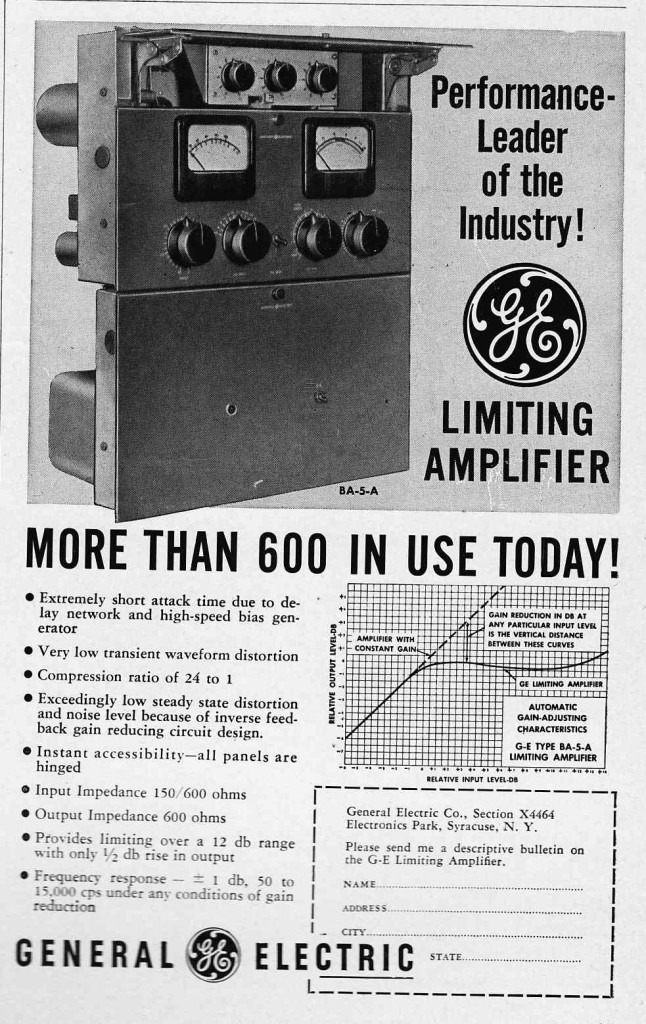 The General Electric (GE) BA-5-A Limiter
The General Electric (GE) BA-5-A Limiter
Continuing our review of the first two years of AUDIO magazine, today we will look at some of the more interesting bits of pro audio kit in evidence during 1954/1955. AUDIO magazine had just made the transition to its new moniker in the wake of the introduction of the AES Journal (Audio Engineering Society), and for the moment, AUDIO sill covered a bit of the pro audio equipment that would soon largely leave its pages.
The GE BA-5 pictured above is, AFAIK, the largest and most complicated analog audio compressor ever made. Although it has much less tubes, it’s kinda even more sophisticated than the Fairchild 660/670. Here’s the schematic if you are interested. From what i recall, the BA-5 works by creating an ultra high frequency sidechain to obtain the control voltage value for the compression; I can’t recall the details at the moment but the basic concept was to allow the unit to have huge amounts of compression with very fast timings, but without any pumping or dipping artifacts. Which was also the intent of the 660/670 design. If anyone out there has a better explanation of this monster, please chime in.
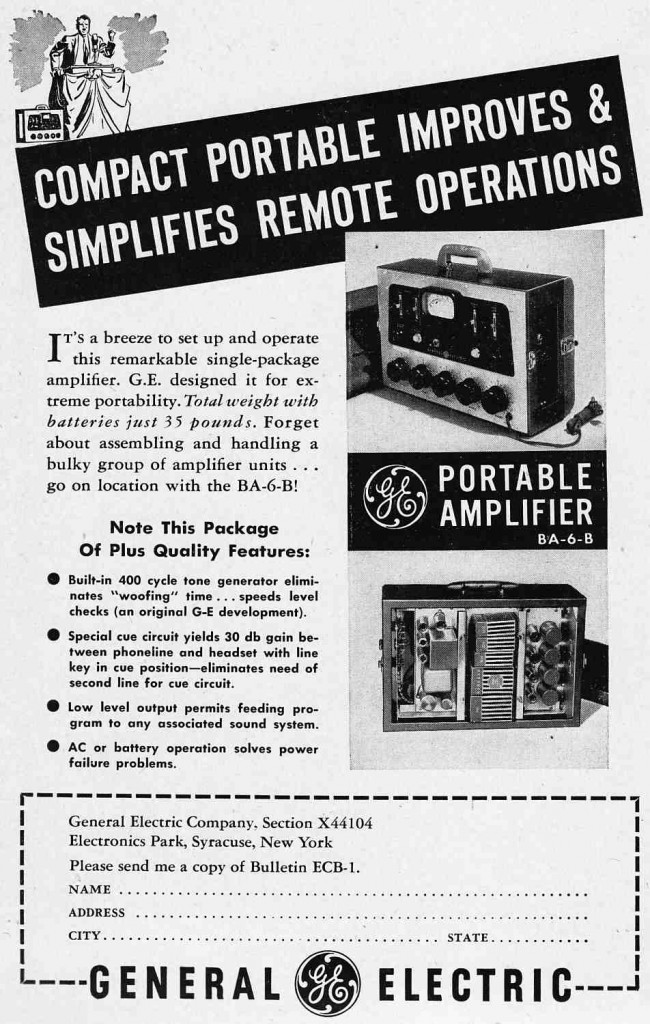 The General Electric BA-6-B remote amplifer/mixer
The General Electric BA-6-B remote amplifer/mixer
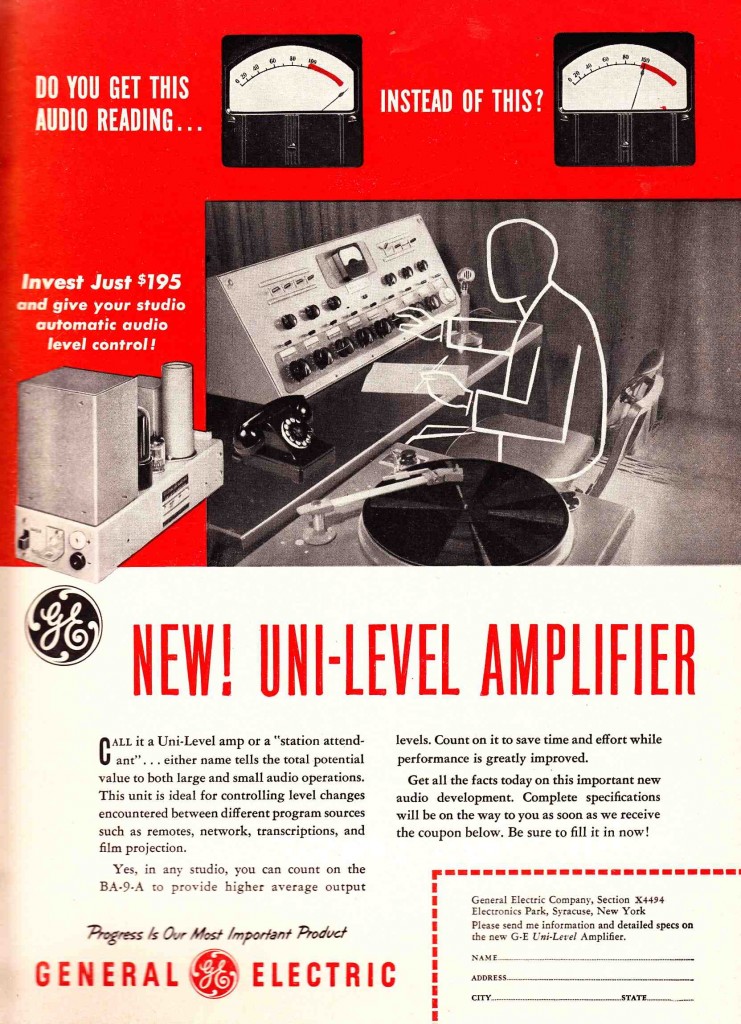 The General Electric BA-9-A compressor, a much more basic pro audio compressor. Circuit is essentially the same as the Gates Sta-Level. The BA-9 is also known as the the uni-level; schematics are readily available online.
The General Electric BA-9-A compressor, a much more basic pro audio compressor. Circuit is essentially the same as the Gates Sta-Level. The BA-9 is also known as the the uni-level; schematics are readily available online.
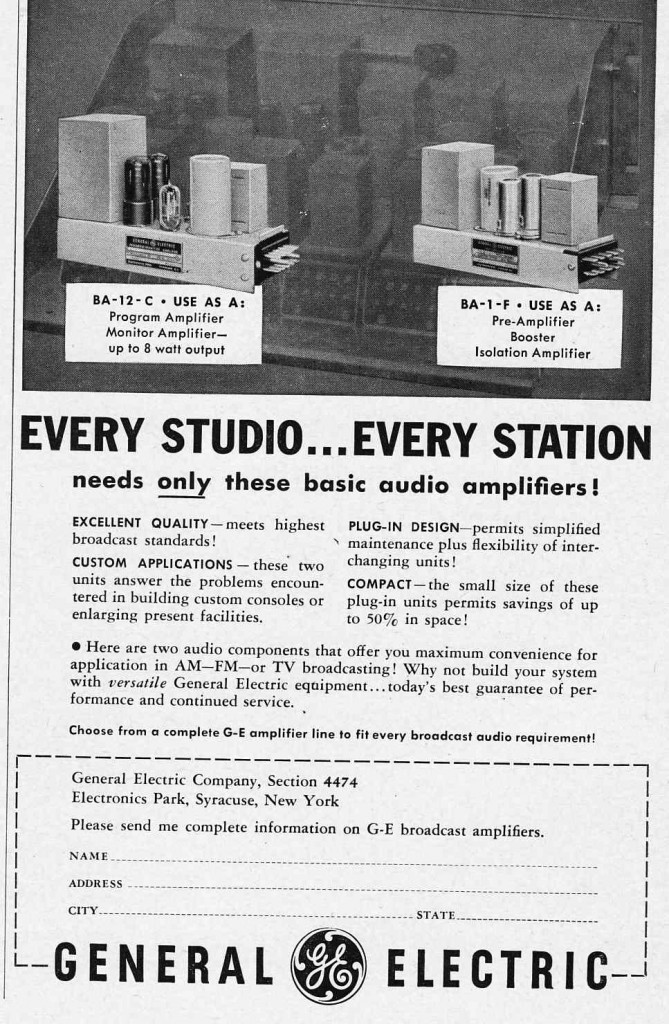 The General Electric BA-1-F plug-in preamp and BA-12-C plug-in power amp
The General Electric BA-1-F plug-in preamp and BA-12-C plug-in power amp
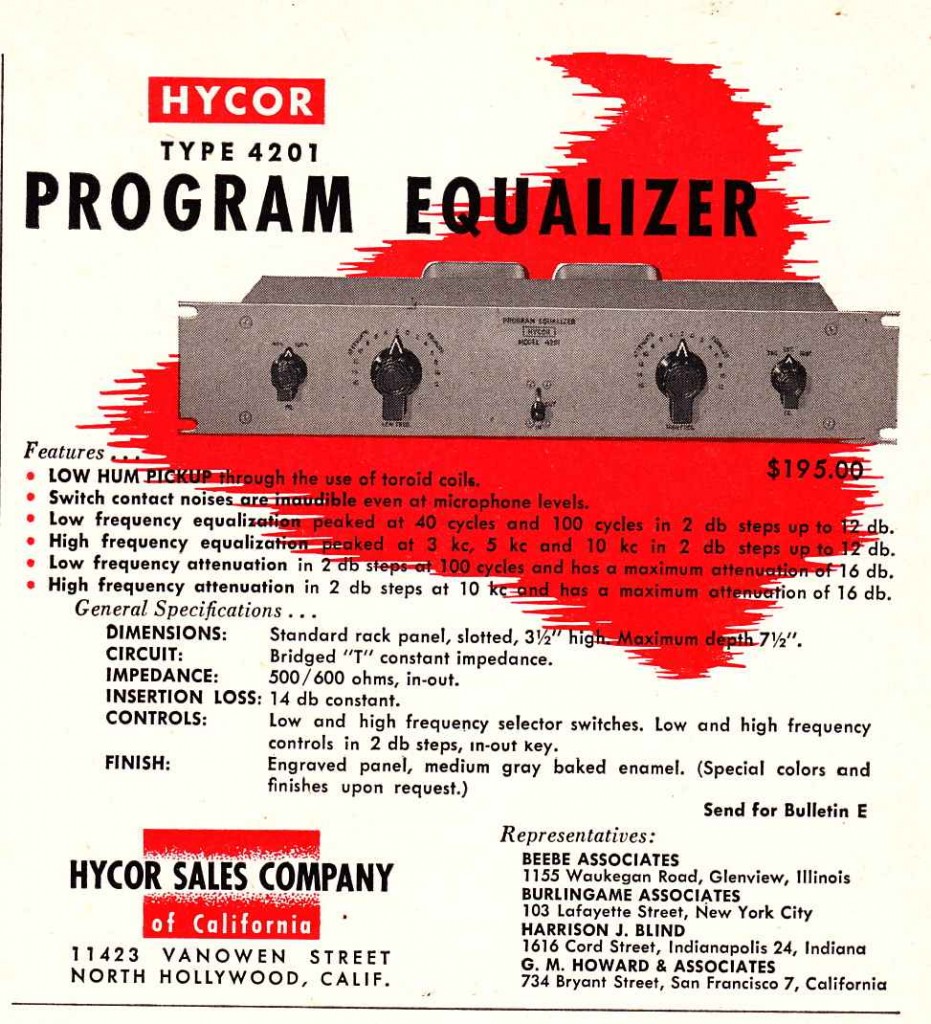 The Hycor 4201 equalizer. Similar to a Pultec program EQ but without the makeup gain amp; the Hycor is a fully passive device.
The Hycor 4201 equalizer. Similar to a Pultec program EQ but without the makeup gain amp; the Hycor is a fully passive device.
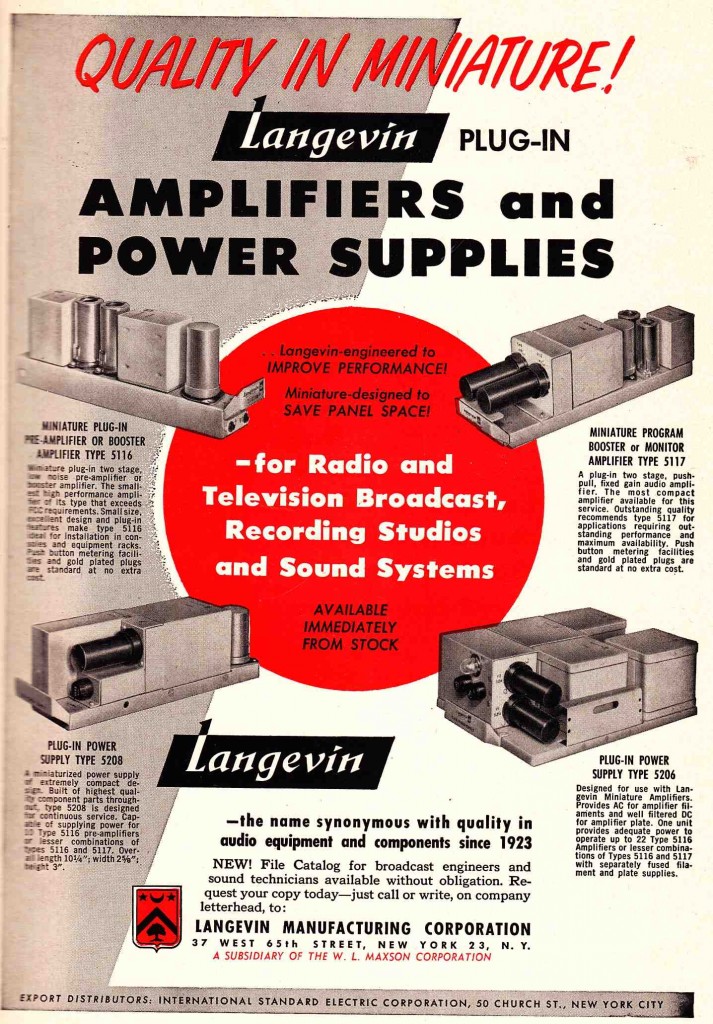 The full Langevin modular line of 1954: 5116 preamp, 5117 power amp, and 5206, 5208 power supplies
The full Langevin modular line of 1954: 5116 preamp, 5117 power amp, and 5206, 5208 power supplies
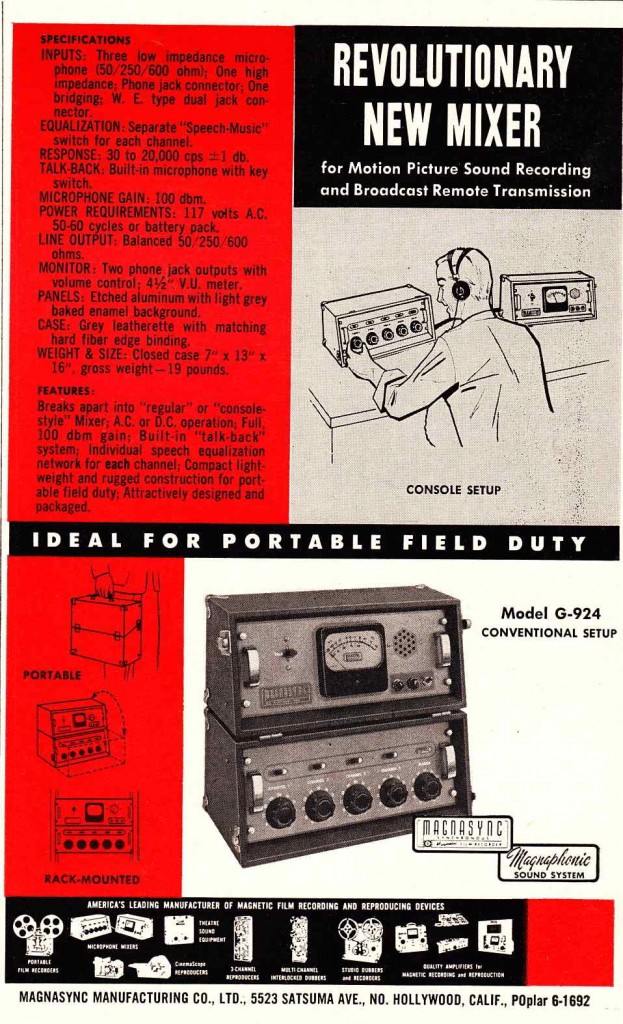 Another remote amp from 1954 – the Magnasync G-924. Looks very cool. Magnasync would soon be merged with the Moviola corporation and become a brand name for sound-for-film equipment. See this previous post for an experiment with the Magnsync URS device.
Another remote amp from 1954 – the Magnasync G-924. Looks very cool. Magnasync would soon be merged with the Moviola corporation and become a brand name for sound-for-film equipment. See this previous post for an experiment with the Magnsync URS device.
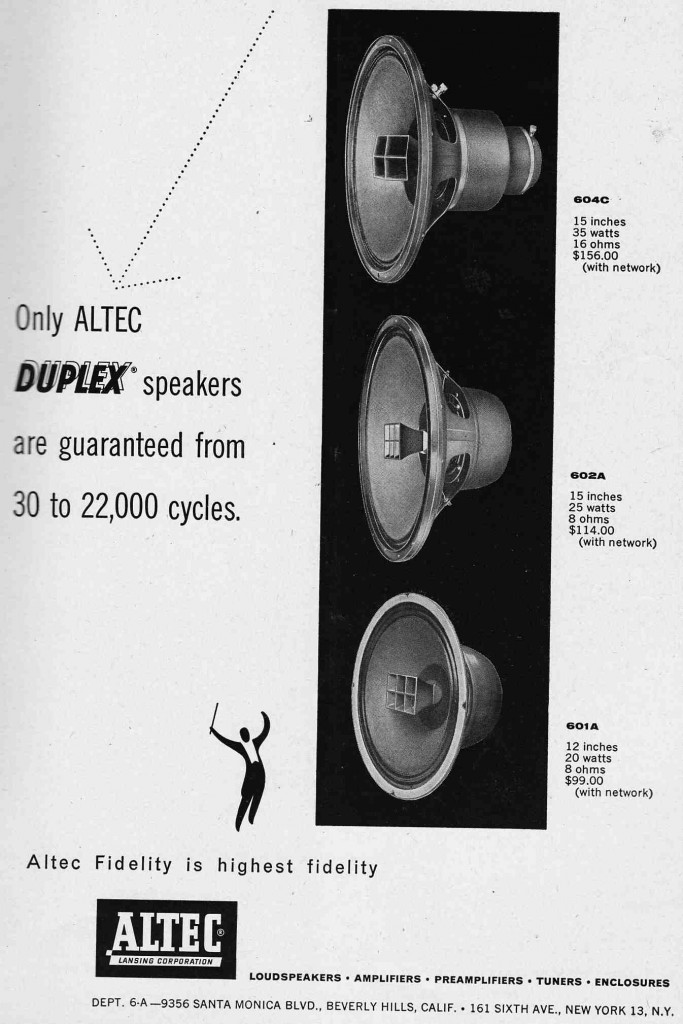 An early ad (1955) for the Altec 604 duplex loudspeaker. The 604 would remain a studio-standard recording/mixing monitor speaker well into the 1970s.
An early ad (1955) for the Altec 604 duplex loudspeaker. The 604 would remain a studio-standard recording/mixing monitor speaker well into the 1970s.
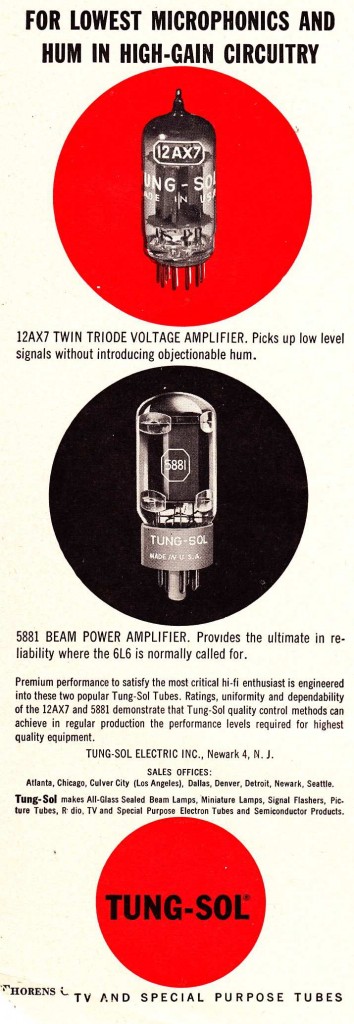 Okay this is getting pretty tech-y but here’s an advert announcing some new-ish tubes you might want to consider: the Tung-sol 12AX7 and the 5881 (AKA ruggedized 6L6). Transistors were on the market at this point (1955) but were a ways off from reaching the performance and reliability that these great tubes offered.
Okay this is getting pretty tech-y but here’s an advert announcing some new-ish tubes you might want to consider: the Tung-sol 12AX7 and the 5881 (AKA ruggedized 6L6). Transistors were on the market at this point (1955) but were a ways off from reaching the performance and reliability that these great tubes offered.
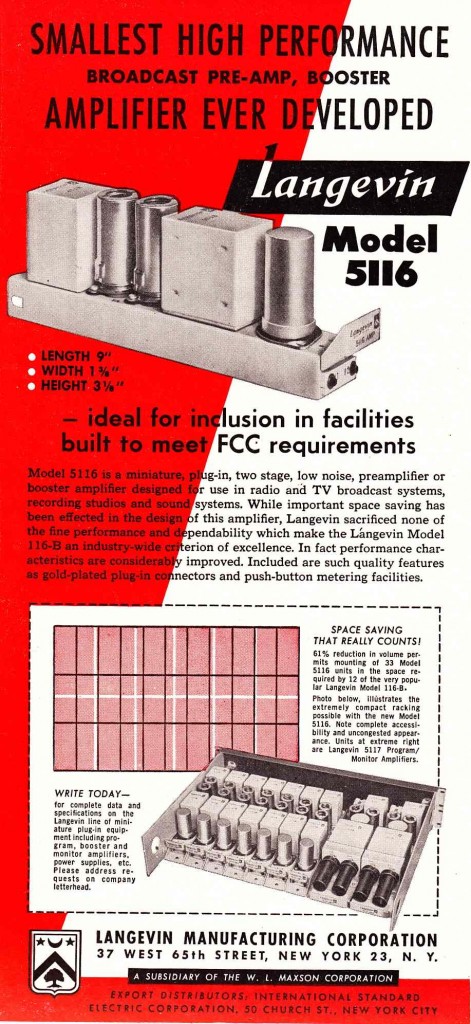
9 replies on “Pro Audio hardware of the early 1950s”
The GE BA-5 works by multiplying the audio path itself, so that any thumping etc becomes subsonic and gets filtered out, after the audio is divided back to the original frequencies. While I’m very glad the 660/670 happened, earlier units were already free of these issues. The Gates Sta-Level in 1956 and Level Devil in 1957 definitely tromped the BA-5 and 660 by miles for broadcasting, by adding a gate to the compression so that it wasn’t gaining up the noise floor with no other signal present. And so started the long history of advancements in broadcast audio processing, one which 99.9% of studio engineers know little to nothing about its innovations.
Right. Thank you. this is all coming back to me now. by multiplying the frequency of the audio signal into above-sonic level, performing the compression operation on that multiplied audio, and then bringing that compressed signal back down to the original frequency… then you can add a VERY low high-pass filter and clear out all the thumping. right. genius. Just out of curiosity, Jesse, any idea what the hi-pass filter frequency is in the unit? thanks –
I have used the GE Ba-5A limiter in actual practice and even for it’s age I love it. That network of inductors and capacitors in the main audio channel is an all-pass filter circuit that rolls the phase of the higher frequencies 180 degrees. This helps to even out the positive and negative peaks , especially of the human voice. ( think Khan semetri-peak) In this case the low frequencies remain phase normal as the higher ones are spinning around the axis. The control voltage is developed ahead and parallel to the main audio, then is applied to the feedback limiter tubes in real time to vary the amount of gain. This limiter has instantaneous attack time and when working properly has a transparent sound quality. True, at 75 pounds and some new state of the art equipment that you can hold in one hand that will do all that and more, what can I say?
I have the GE BA- 5A schematic in front of me. The input to the side chain amp ( 6J5 ) tube is taken from the plate of the second pre-amp tube. The signal phase is then split to drive two tubes in a novel push-pull cathode follower circuit to obtain a low impedance for development of the d.c. gain control voltage. This allows for an extremely fast attack time for the feed back limiter circuit. (two 6J5’s between the output of the amp to the input) As the control voltage decreases the negative bias voltage the amount of signal fed back to the input ( being 180 deg. out of phase) increases, decreasing the overall gain of the amp. This is a feed-back limiter.
The BA 5A limiter was used to some degree in radio broadcasting stations as late as the 1970’s as a peak limiter to prevent over-modulation of the carrier wave. Some stations used an AGC amplifier such as the “Gates” sta-level (or other) ahead of it to keep a reasonable modulation average while staying within the 10-12 db limiting range of the BA-5A, usually about 3-5db limiting. The audio delay circuit spoken of in the ” theory of operation” section of the manual is an all pass filter with phase rotating properties at higher frequencies. This would help to even out the positive and negative audio peaks especially on microphone voice signals which usually predominate on the positive or negative side depending on microphone phasing. This also helps to prevent over-modulation of the transmitter.
Hi Howard,
I might have met you in 1970 when I worked at KXLE in north central Washington. We had a GE BA 5A limiter on the air there. It was preceded by a Gates Sta- Level. The combination worked quite well and sounded very smooth.
Hi!
this gear is so interesting.
I have a pair of GE A1 -301 convertible amplifier ( power + preamplifier) that looks much more professional than a home system with a lot of features and filters.
It is great to rescue and give them a good use. The sound is awesome.
best,
Kurt
What’s up,I check your blog named “Pro Audio hardware of the early 1950s | Preservation Sound” on a regular basis.Your humoristic style is witty, keep doing what you’re doing! And you can look our website about love spells.
It seems that Howard’s info makes sense when I look through the schematic. It is a feedback limiter with feed-forward side chain. The first comment however from JesseG does not make sense. If there is a multiplication or transposition of the audio frequencies then that would need to be explained in detail. I do not see any RF-like circuit elements in there